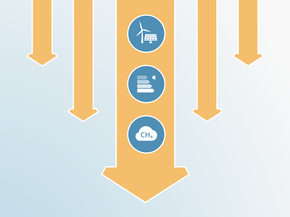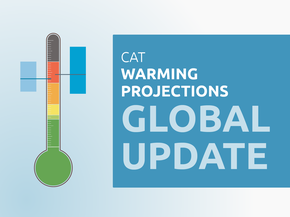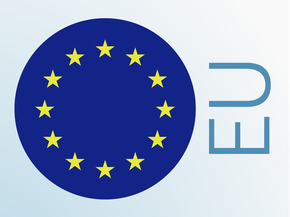Country summary
Overview
Russian climate ambition is extremely low, with few policies introduced since the last CAT assessment in 2022. The only major climate policy updates since then have been the high-level Climate Doctrine, which was revised to remove any mention of the role fossil fuels play in driving the climate crisis, and the announcement of Russia’s headline 2035 target, which according to our calculations will be achieved without any additional effort. The war in Ukraine has altered Russia’s political landscape, with the government suppressing environmental organisations critical of state policies amidst a doubling down on fossil fuel production.
In 2024, Russia recalculated its land use, land-use change and forestry (LULUCF) sector’s carbon absorption capacity. This has almost doubled the LULUCF sink estimate in Russia’s favour, to almost exactly what it needs to meet its 2050 LULUCF target of absorbing 1.2 GtCO2e. Its 2050 goal has now effectively been met with little additional effort needed. Russia plans to heavily rely on the LULUCF sector’s absorption capacity to achieve its 2030 and 2035 targets, while its 2060 climate target allows it to continue emitting 1.2 GtCO2e due to the LULUCF sector’s bloated impact.
Russia’s figures are questionable, given official reporting on wildfires has been significantly lower than independent analyses based on satellite data. Many of these wildfires occur in unmanaged forests, leading to extraordinarily large fires. Russia includes unmanaged forests in its inventory – contrary to UNFCCC protocol – and reports it as a major sink. Full transparency around its LULUCF data is needed. Russia’s weak NDC and climate policies result in the CAT giving Russia an overall rating of “Critically Insufficient”.
Russia’s 2035 emissions reduction target, signed by President Putin as an executive order in August 2025, commits to reducing GHG emissions to 65–67% of 1990 levels (including LULUCF) by 2035, or a 33–35% reduction below 1990 levels. The target was submitted to the UNFCCC on September 29, 2025. Russia is already set to achieve its 2035 emissions target under current policies, which would lead to an emissions level of 35% below 1990 levels. Russia’s 2035 target therefore does not increase ambition beyond business as usual. This runs completely contrary to Paris Agreement principles, which require NDCs to reflect a country’s highest possible ambition. Russia’s 2035 target not only fails to reflect highest ambition, but does not increase ambition at all.
Russia’s economy remains heavily reliant on fossil fuel revenues, and its fossil fuel industry exerts considerable influence over energy policy. In its Energy Strategy to 2050, published in 2025, Russia reaffirms its commitment to a fossil fuel-intensive future, with the share of coal in the energy mix projected to be ten times larger than that of wind and solar. In conjunction with its overarching energy strategy, Russia released two power sector strategies which outline a similar reliance on fossil fuels – the strategies envision wind and solar making up just 3.3% of electricity generation by 2042.
Russian projections expect increased international demand for Russian hydrocarbons. Such projections are out of step with market trends, International Energy Agency forecasts, and the forecasts of Russia’s own Central Bank. A growing emphasis on exporting fossil fuels to Asia is not expected to make up for the loss in sales to Europe, which is expected to fully stop buying Russian oil and gas by the end of 2027. Russia’s energy policy instead represents the interests of its influential fossil fuel industry, risking Russia’s economic growth by failing to diversify its economy.
In meeting these demand projections, Russia also intends to exploit hydrocarbon resources in the Arctic Circle. This is becoming increasingly central to government thinking, as the Arctic’s melting ice opens up new fossil fuel resources which state-owned companies can exploit.
Russia is failing to harness its vast renewable energy potential. Weak regulatory support and low investment mean that the domestic renewables industry is struggling to find its feet. By providing financial and policy support in the early stages, Russia could develop a profitable domestic industry that would diversify the economy and broaden its relations with neighbouring countries beyond the prism of fossil fuels.
Recent positive developments include:
- The expansion of Moscow’s public transport system has been a bright spot in the Russian climate space. Moscow has directed significant investments towards upgrading its metro system and is a European leader in rolling out electric buses.
To improve its climate targets and action rating, Russia could:
- Increase NDC ambition beyond what will already be achieved with current policies, so that the NDC actually drives emission reductions.
- Align its new energy strategy with realistic projections. Expectations of ever-growing demand are unrealistic and risk saddling Russia with stranded assets while failing to use investments to diversify its economy.
- Support its domestic renewables industry by providing similar political and regulatory support that it once afforded to its nuclear industry. Russia has vast renewables potential, and as its nuclear industry shows, strong support can create the conditions for a thriving new industry.
- Invest in a just transition for its coal workers. Regardless of the Kremlin’s optimistic projections, coal demand will fall. Coal mining regions such as the Kuzbass will need investments and upskilling to support workers as coal demand drops.
- Transparently show how LULUCF emissions are accounted for, and follow UNFCCC accounting guidelines. As it stands, it is difficult to believe the government’s figures.
Description of CAT ratings
The CAT rates each country’s targets and policies against (1) its fair share contribution to climate change mitigation considering a range of equity principles including responsibility, capability and equality, and (2) what is technically and economically feasible using modelled domestic pathways which in absence of a better method are based on global least-cost climate change mitigation.
Comparing a country’s fair share ranges and modelled domestic pathways provides insights into which governments should provide climate finance and which should receive it. Developed countries with large responsibility for historical emissions and high per-capita emissions, must not only implement ambitious climate action domestically but must also support climate action in developing countries with lower historical responsibility, capability, and lower per-capita emissions.
The CAT rates Russia’s climate targets, policies and finance as "Critically insufficient." This rating indicates that Russia’s climate policies and commitments reflect minimal to no action and are not at all consistent with the Paris Agreement’s 1.5°C temperature limit.
Russia failed to increase its ambition when it submitted its 2030 NDC update in November 2020. We rate the updated 2030 NDC target as “Critically insufficient” when compared to modelled domestic pathways and “Critically insufficient” when compared with its fair share emissions allocation. Russia is also not providing adequate climate finance, which we rate as "Critically insufficient." The weak 2030 target will easily be met under existing policies and action, which we rate as “Critically insufficient."
Russia needs to set a more ambitious target for emission reductions, adopt and implement additional policies, and provide additional finance to improve its CAT rating.
Russia’s efforts to tackle climate change are inadequate. Under current policies, Russia’s economy-wide emissions (excl. LULUCF) are expected to continue rising to 2030, or at best stabilise, when they should be rapidly declining; especially for one of the world's large emitters. The policies and action rating remains "Highly insufficient."
The CAT rates Russia’s current policies as “Highly insufficient” when compared to its fair share. In the previous update, we rated Russia’s current policies compared to modelled domestic pathways. In this update, we rated Russia's current policies compared to fair share because we take the better rating when compared to our two frameworks (for more details, see our methodology). The rating remains “Highly insufficient,” indicating that emissions under Russia’s policies and actions in 2030 are not at all consistent with limiting warming to 1.5°C. If all countries were to follow Russia’s approach, warming could reach over 3°C and up to 4°C.
Russia is committed to propping up its fossil fuel industry and its Arctic policy aims to expand hydrocarbon production deeper into the Arctic circle. Meanwhile, its 2024 target of a 4.5% share of renewables electricity generation (excl. hydropower) was missed, and Russia now aims to increase the share to just 3.3% by 2042.
The full policies and action analysis can be found here.
We rate Russia’s 2030 NDC target of a 30% reduction below 1990 levels by 2030 as “Critically insufficient” when compared to modelled domestic emissions pathways. This rating indicates that Russia’s NDC target in 2030 reflects minimal to no action and is not at all consistent with modelled domestic pathways limiting warming to 1.5°C. If all countries were to follow Russia’s approach, warming would exceed 4°C.
While Russia has not submitted a 2030 NDC target since the last CAT update, our rating has changed from ”Highly insufficient” to "Critically insufficient.” This rating change is due to a methodological update of our modelled domestic pathways (MDPs), which now incorporate the latest global least-cost pathways from the IPCC Sixth Assessment Report, and a change in our methodology for quantifying Russia’s 2030 NDC.
We rate Russia’s 2030 NDC target of a 30% reduction below 1990 levels as “Critically insufficient” when compared to its fair share emissions allocation. The “Critically insufficient” rating indicates that Russia’s target, when compared to what its fair share would be in 2030, reflects minimal to no action and is not at all consistent with limiting warming to 1.5°C. Russia’s target is not in line with any interpretation of a fair approach to meeting the 1.5°C temperature limit. If all countries were to follow Russia’s approach, warming would exceed 4°C.
Russia’s international public finance contributions are rated “Critically insufficient." Under the CAT’s methodology, Russia has not made any substantial contribution to international climate finance for mitigation action. To improve its rating, Russia needs to urgently increase its financial contributions and stop funding fossil fuels abroad.
Russia’s climate finance is not sufficient to improve its fair share rating, and the CAT rates Russia’s overall fair share contribution as "Critically insufficient."
Russia’s land use, land use change and forestry (LULUCF) sector underwent major recalculations in Russia’s 2024 national inventory report. For example, the previous, 2023 inventory reported LULUCF emissions at -505 MtCO2e in 2021 (when converted to AR5), while the 2025 inventory reported them as -750 MtCO2e in 2021. In the last two years, the emissions absorption capacity of Russia’s LULUCF sector has nearly doubled, acting as a carbon sink of up to 1,172 MtCO2e in 2023.
These figures are difficult to believe, particularly as official reporting of wildfires has been far lower than independent analyses based on satellite data. Russia’s inclusion of unmanaged forests in its LULUCF reporting runs directly contrary to UNFCCC norms, which state that only managed forests are to be included in national inventories.
The Russian Federation approved its "Strategy of socio-economic development of the Russian Federation with low greenhouse gas emissions by 2050" in October 2021 and submitted it to the UNFCCC in September 2022. Afterwards, it submitted an action plan designed to meet the 2050 target. While the action plan is detailed out to 2030, it does not provide quantified emissions reduction targets for economic sectors or subsectors out to 2050 which could orient long-term planning across ministerial agencies. The CAT evaluates the net zero target’s comprehensiveness as "Poor."
The full net zero target analysis can be found here.
Further analysis
Latest publications
Stay informed
Subscribe to our newsletter




